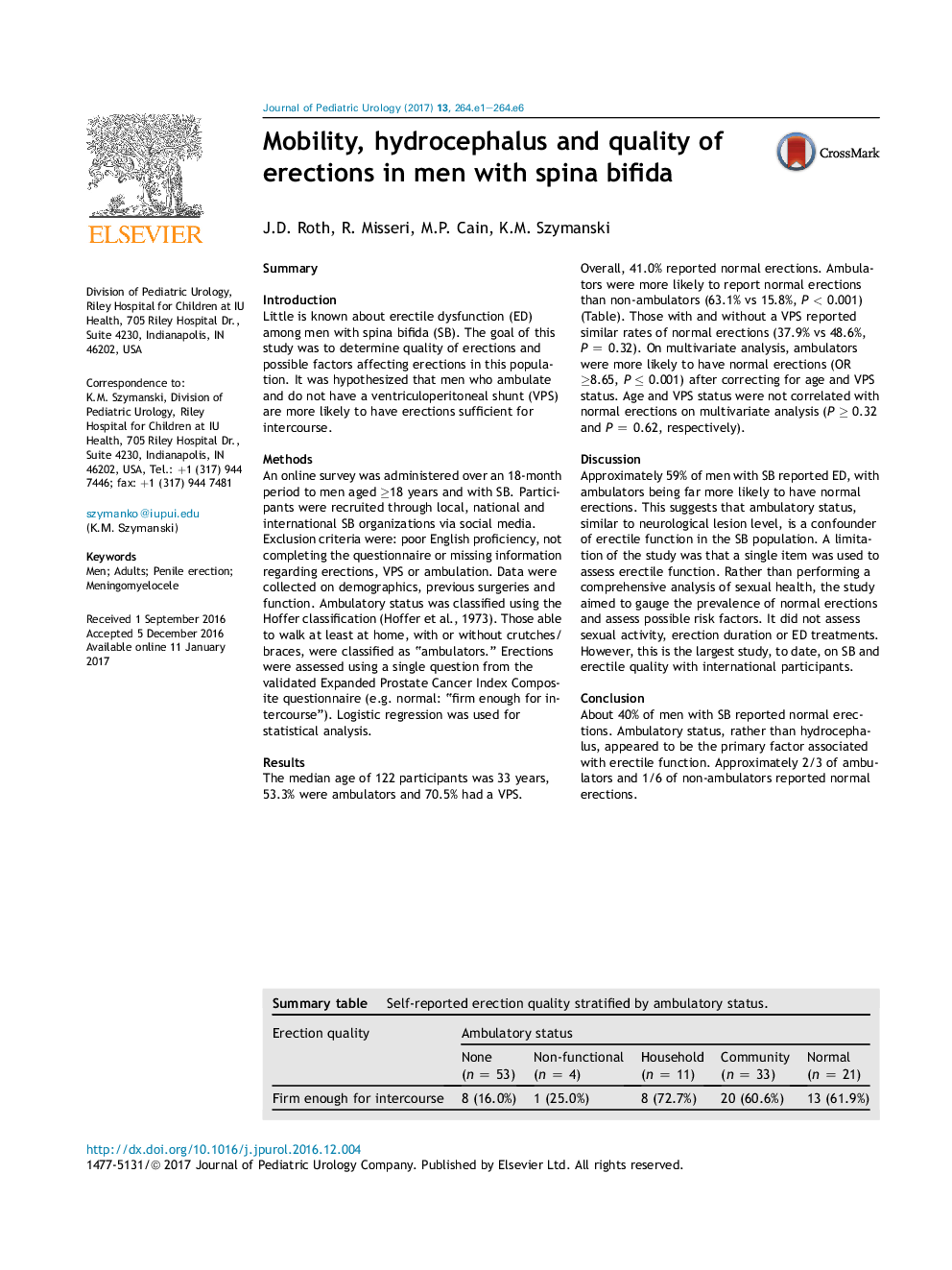| کد مقاله | کد نشریه | سال انتشار | مقاله انگلیسی | نسخه تمام متن |
|---|---|---|---|---|
| 5718582 | 1411254 | 2017 | 6 صفحه PDF | دانلود رایگان |
SummaryIntroductionLittle is known about erectile dysfunction (ED) among men with spina bifida (SB). The goal of this study was to determine quality of erections and possible factors affecting erections in this population. It was hypothesized that men who ambulate and do not have a ventriculoperitoneal shunt (VPS) are more likely to have erections sufficient for intercourse.MethodsAn online survey was administered over an 18-month period to men aged â¥18 years and with SB. Participants were recruited through local, national and international SB organizations via social media. Exclusion criteria were: poor English proficiency, not completing the questionnaire or missing information regarding erections, VPS or ambulation. Data were collected on demographics, previous surgeries and function. Ambulatory status was classified using the Hoffer classification (Hoffer et al., 1973). Those able to walk at least at home, with or without crutches/braces, were classified as “ambulators.” Erections were assessed using a single question from the validated Expanded Prostate Cancer Index Composite questionnaire (e.g. normal: “firm enough for intercourse”). Logistic regression was used for statistical analysis.ResultsThe median age of 122 participants was 33 years, 53.3% were ambulators and 70.5% had a VPS. Overall, 41.0% reported normal erections. Ambulators were more likely to report normal erections than non-ambulators (63.1% vs 15.8%, P < 0.001) (Table). Those with and without a VPS reported similar rates of normal erections (37.9% vs 48.6%, P = 0.32). On multivariate analysis, ambulators were more likely to have normal erections (OR â¥8.65, P â¤Â 0.001) after correcting for age and VPS status. Age and VPS status were not correlated with normal erections on multivariate analysis (P â¥Â 0.32 and P = 0.62, respectively).DiscussionApproximately 59% of men with SB reported ED, with ambulators being far more likely to have normal erections. This suggests that ambulatory status, similar to neurological lesion level, is a confounder of erectile function in the SB population. A limitation of the study was that a single item was used to assess erectile function. Rather than performing a comprehensive analysis of sexual health, the study aimed to gauge the prevalence of normal erections and assess possible risk factors. It did not assess sexual activity, erection duration or ED treatments. However, this is the largest study, to date, on SB and erectile quality with international participants.ConclusionAbout 40% of men with SB reported normal erections. Ambulatory status, rather than hydrocephalus, appeared to be the primary factor associated with erectile function. Approximately 2/3 of ambulators and 1/6 of non-ambulators reported normal erections.Summary table. Self-reported erection quality stratified by ambulatory status.Erection qualityAmbulatory statusNone (n = 53)Non-functional (n = 4)Household (n = 11)Community (n = 33)Normal (n = 21)Firm enough for intercourse8 (16.0%)1 (25.0%)8 (72.7%)20 (60.6%)13 (61.9%)
Journal: Journal of Pediatric Urology - Volume 13, Issue 3, June 2017, Pages 264.e1-264.e6
